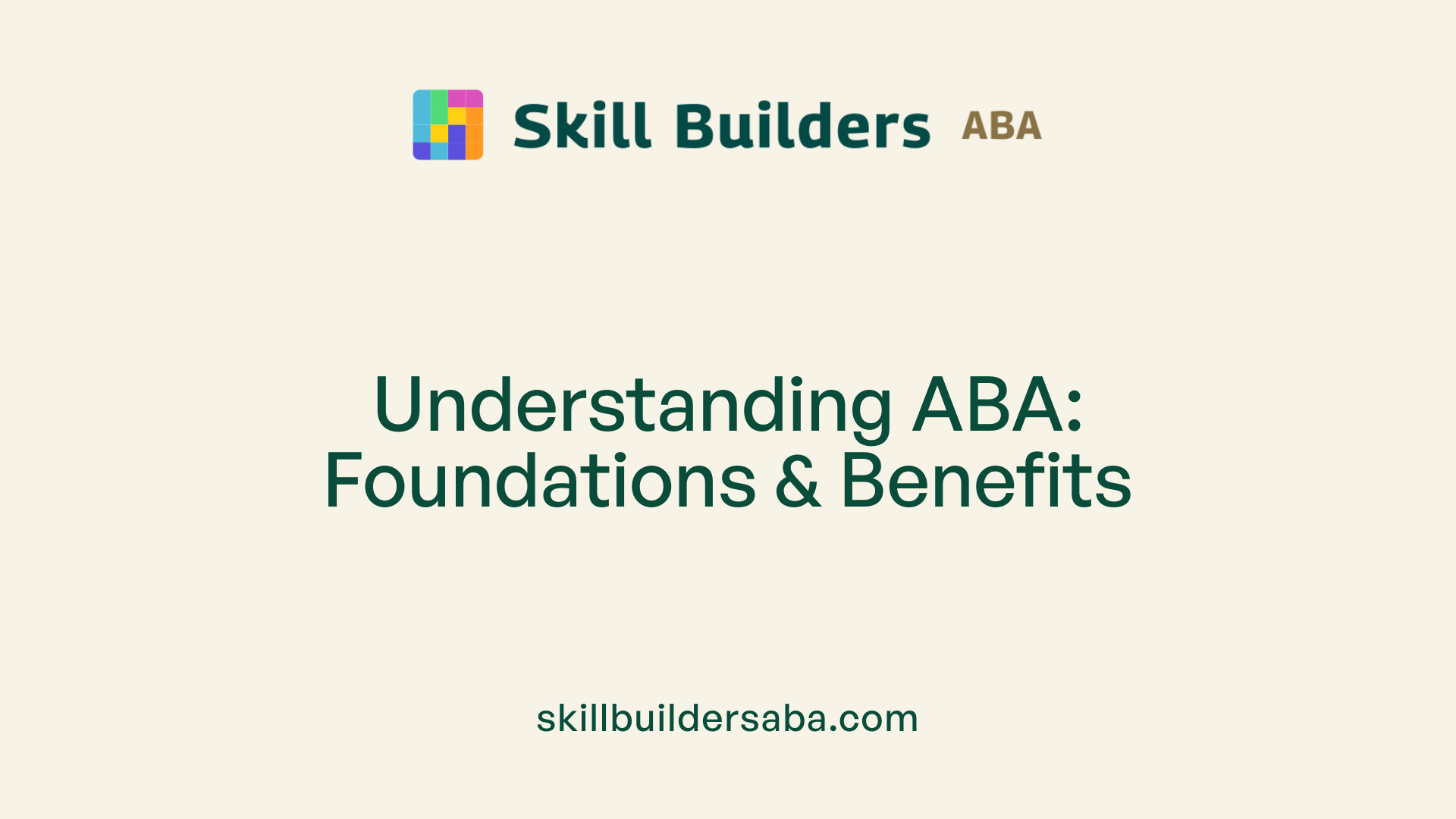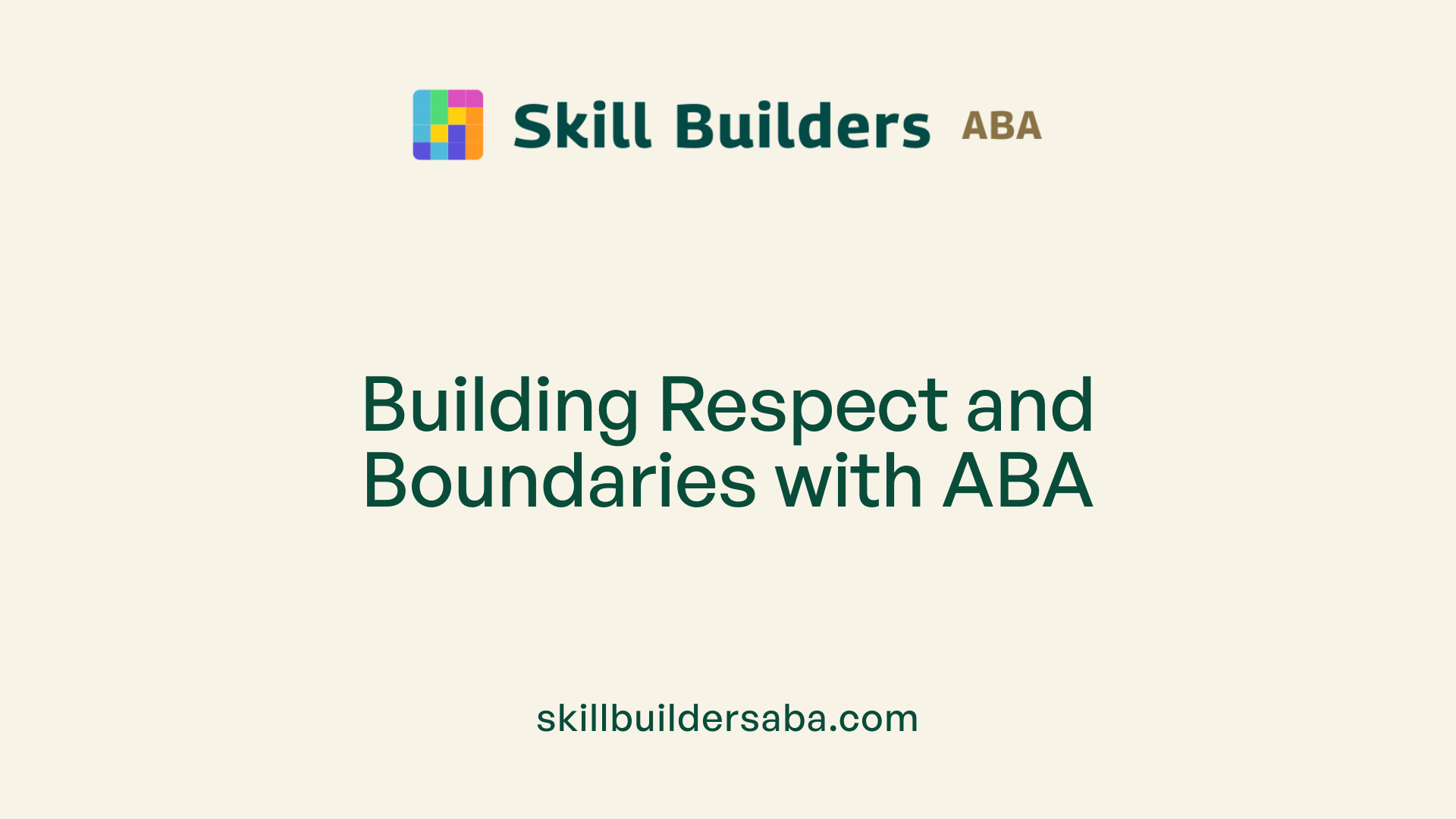
Teaching boundaries and consent using ABA
Harnessing Applied Behavior Analysis to Cultivate Healthy Boundaries and Consent Skills in Children with Autism
Understanding ABA and Its Role in Teaching Boundaries and Consent
Applied Behavior Analysis (ABA) is a scientifically grounded therapy that supports children with autism spectrum disorder (ASD) in developing essential life skills. Among these, learning about personal boundaries and consent is vital for social interaction and safety. This article explores how ABA therapy uniquely approaches teaching these complex concepts, detailing methods, practitioner roles, benefits, and challenges.
Applied Behavior Analysis: Foundations and Therapeutic Use in Autism

What is Applied Behavior Analysis (ABA) therapy, and how is it used to treat autism?
Applied Behavior Analysis (ABA) therapy is a scientifically validated approach that uses behavioral principles to improve the lives of children with autism spectrum disorder (ASD). It focuses on increasing beneficial behaviors such as communication, social skills, and daily living abilities, while reducing challenging or disruptive behaviors.
ABA programs are highly individualized, designed to break down skills into manageable steps and reinforce each success. Positive reinforcement is central; desired behaviors are encouraged by rewarding progress, which helps children learn and maintain new skills. The therapy is adaptable to various settings including specialized therapy sessions, classrooms, and home environments, ensuring generalization of skills.
Core ABA techniques used for skill development
Several teaching methods underpin ABA's effectiveness:
- Discrete Trial Teaching breaks skills into small components, using cues and consequences to teach each part.
- Naturalistic Teaching builds on a child's interests during everyday activities to encourage communication.
- Pivotal Response Treatment targets crucial developmental areas like motivation and social initiations, fostering broader improvements.
- Token Economy employs tokens as rewards that children can exchange for preferred items or activities.
- Contingent Observation involves brief timeouts where children learn appropriate behavior by observing peers.
These strategies are combined depending on the child’s unique needs, providing a customized path to improve communication, social interaction, and independence.
Settings and delivery of ABA programs
ABA can be delivered through structured one-on-one sessions or embedded into natural routines at home or school. For example, intervention might consist of multiple weekly sessions, each an hour long, where therapists teach and reinforce skills. Parents are often trained in ABA techniques to maintain consistency and generalize learning beyond therapy sessions.
ABA's focus on behavioral improvement and independence
The ultimate goal of ABA is to empower children with autism by fostering independence and quality of life. By teaching practical skills like following directions, self-care, and social interaction, ABA supports children in becoming more adept at navigating daily challenges. Early intervention—typically starting between ages 2 and 6—is recognized as especially beneficial.
Equally important is a respectful approach that honors each child's individuality and prioritizes well-being. Safe and effective ABA practice involves collaboration with caregivers, focuses on meaningful skills, and balances therapy with play and relaxation.
| Aspect | Details | Purpose |
|---|---|---|
| Definition | Behavior-based therapy improving skills and reducing challenges in children with autism | Enhances independence and social functioning |
| Core Techniques | Discrete Trial Teaching, Naturalistic Teaching, Pivotal Response Treatment, Token Economy, Observation | Tailor learning methods to child's needs |
| Delivery Settings | Therapy sessions, classrooms, home environments, parental involvement | Promotes consistency and generalization of learned skills |
| Behavioral Focus | Positive reinforcement, skill development, reducing problematic behaviors | Support adaptive behaviors and meaningful participation |
How ABA Techniques Address Teaching Boundaries and Consent

Behavior Modification Strategies
ABA uses behavior modification techniques such as positive reinforcement to encourage appropriate behaviors related to understanding boundaries and consent. By rewarding desirable responses, children with autism spectrum disorder (ASD) learn to respect personal space and recognize social limits.
Breaking Down Complex Skills into Manageable Steps
To teach these complex social skills, ABA breaks them into smaller, manageable steps. For example, understanding "no" or recognizing when to pause in interaction are taught incrementally. This step-by-step approach helps children grasp subtle social cues effectively.
Use of Reinforcement to Encourage Appropriate Responses
Reinforcement plays a crucial role in encouraging children to respond correctly in boundary and consent situations. Tokens, praise, or other rewards are given when a child demonstrates respect for boundaries or appropriately seeks permission, strengthening these positive behaviors.
Incorporating Naturalistic and Discrete Trial Teaching
Teaching methods like Naturalistic Teaching take advantage of a child's interests and real-life routines to practice consent in everyday contexts, such as sharing toys or asking for help. Discrete Trial Teaching uses structured cue-response-consequence formats to specifically target social skills required for understanding boundaries, allowing for clear feedback and learning.
By combining these ABA strategies, children with ASD receive individualized and supportive instruction that promotes respectful social interactions and consent awareness.
Key ABA Teaching Strategies Relevant to Social and Behavioral Skills
Discrete Trial Teaching and Its Role in Social Skills
Discrete Trial Teaching (DTT) is a structured ABA strategy that breaks down complex skills into smaller, manageable components. This method follows a cue-response-consequence format, making it especially effective for students who need help improving social skills. By focusing on one skill at a time and reinforcing correct responses, DTT helps children with autism gradually learn appropriate social interactions.
Naturalistic Teaching Leveraging Child’s Interests
Naturalistic Teaching harnesses the child's natural interests and daily routines to foster communication and learning. Strategies like incidental teaching encourage children to communicate and interact during natural activities, making learning meaningful and engaging. This child-led approach promotes spontaneity and generalization of skills across different environments.
Pivotal Response Treatment Focusing on Motivation and Social Initiations
Pivotal Response Treatment (PRT) targets core developmental areas such as motivation, responsivity to multiple cues, social initiations, and self-management. By improving these pivotal behaviors, PRT often leads to widespread improvements in communication and social skills. The approach emphasizes child choice and reinforcing attempts at communication to boost engagement.
Token Economy Systems to Reinforce Positive Behavior
Token Economy systems use tokens or symbols that children earn for exhibiting positive behaviors. These tokens can later be exchanged for preferred rewards or activities, motivating students to maintain appropriate behavior. This reinforcement method is commonly used in classrooms to encourage both learning and social interaction.
Contingent Observation for Managing Inappropriate Behavior
Contingent Observation is a mild timeout strategy where a child observes peers while being temporarily removed from disruptive activities. During this time, children learn more appropriate behavior by observing others and receiving guidance, helping them self-regulate without harsh punishment.
These strategies, grounded in behavioral principles, provide diverse tools educators and therapists can use to support social and behavioral development in children with autism spectrum disorder. Each approach can be tailored to individual needs, maximizing engagement and effectiveness.
Who Provides ABA Therapy? Qualifications and Roles Explained

Who typically provides ABA therapy, and what qualifications do these professionals have?
ABA therapy is delivered by a team of trained professionals, each with specific qualifications and roles to ensure effective treatment.
Board Certified Behavior Analysts (BCBAs) are the lead specialists in ABA therapy. They hold postgraduate degrees, have completed extensive supervised fieldwork, and have passed a certification exam in behavior analysis. Their advanced training qualifies them to design individualized treatment plans and supervise the therapy process.
Registered Behavior Technicians (RBTs) are paraprofessionals who have completed focused training and passed competency exams. They work directly with children to implement therapy plans but always under the close supervision of a BCBA.
Behavior Therapists assist in delivering therapy and may have at least a high school diploma. They operate under BCBA direction and help execute intervention strategies.
In some regions, professionals may also hold state licenses such as Licensed Behavior Analysts (LBA), adding a layer of regulatory oversight.
Roles and training requirements
- BCBAs: Graduate education + supervised experience + certification; design and oversee treatment.
- RBTs: Targeted training + exam; direct implementation of therapy.
- Behavior Therapists: Varying education levels; assist in therapy delivery.
Supervision and collaboration with families
BCBAs are responsible for supervising RBTs and Behavior Therapists, ensuring consistent therapy quality. Equally important is collaboration with families to generalize skills learned during therapy into the home environment, enhancing treatment outcomes and supporting the child's development comprehensively.
Benefits of ABA Therapy in Teaching Boundaries and Consent
Improvement in social communication and adaptive behavior
ABA therapy is highly effective in enhancing social communication and adaptive behaviors in children with autism spectrum disorder (ASD). Through behavior modification techniques such as positive reinforcement, children develop vital skills like communication, follow-through on directions, and daily living tasks. This improvement creates a foundation for better social interaction, helping children understand and respond to social cues, which is essential when learning about personal boundaries and consent.
Enhanced understanding of personal space and consent
ABA strategies help children break down complex behaviors into smaller, manageable steps, making it easier to grasp concepts like personal space and consent. Techniques like Discrete Trial Teaching and Naturalistic Teaching utilize structured lessons and natural interests, respectively, enabling children to practice respecting boundaries in different settings. These approaches teach children when and how to seek permission, recognize others' cues, and develop appropriate social responses, promoting respectful interactions.
Parental involvement in reinforcing skills
Parents play a crucial role in the success of ABA by generalizing skills learned during therapy to the home environment. Training parents in ABA methods equips them to reinforce appropriate behavior, monitor progress, and create supportive settings where children practice boundaries and consent consistently. This involvement ensures that the positive effects of therapy extend beyond sessions, improving children's ability to maintain respectful social relationships.
Early intervention advantages
Starting ABA therapy at an early age, typically between 2 and 6 years old, maximizes its effectiveness. Early intervention encourages the development of communication and social skills at a critical period, making it easier for children to learn and adopt respectful behaviors regarding boundaries and consent. Structured teaching and individualized programs tailored to children’s strengths ensure that learning is meaningful and well-supported, reducing challenges related to social interactions later in life.
| Benefit Area | Description | Impact on Boundaries and Consent |
|---|---|---|
| Social Communication | Improved ability to understand and use language and social cues | Enhances recognition of personal space and social appropriateness |
| Adaptive Behavior | Gains in daily living and self-care skills | Supports independence in managing interactions |
| Structured Teaching | Breaking skills into smaller, achievable steps | Facilitates learning consent through clear, manageable tasks |
| Parental Involvement | Engaged caregivers reinforcing therapy skills at home | Promotes generalization and consistent understanding |
| Early Intervention | Therapy starting at critical developmental stages | Builds foundational social skills before challenges deepen |
Challenges of Teaching Boundaries and Consent Through ABA

How Does the Intensity and Structure of ABA Therapy Impact Teaching Boundaries and Consent?
ABA therapy is typically structured and intensive, often involving multiple focused sessions per week. This intensity can be beneficial for skill acquisition, breaking down complex social concepts like boundaries and consent into manageable steps. However, the strict structure, such as the use of discrete trial teaching with its cue-response-consequence format, may sometimes feel rigid, potentially limiting spontaneous learning opportunities important for understanding nuanced social interactions.
How Do Individual Differences and Neurodiversity Considerations Affect ABA Teaching?
Individual differences among children with ASD mean that boundaries and consent must be taught with sensitivity to each child's unique needs and neurodiversity. Safe ABA practices emphasize respecting the child's natural identity and strengths, avoiding generalized programs that ignore personal differences. Without adapting to these factors, therapy risks overlooking important elements of self-awareness and autonomy critical to understanding consent.
How Is Skill Acquisition Balanced with Child Well-being in ABA Therapy?
A major challenge lies in balancing the focus on acquiring social skills, such as appropriate interactions regarding personal space and consent, with preserving the child's well-being. Safe ABA prioritizes involving caregivers to ensure therapy respects individual characteristics and includes play and relaxation alongside learning. Overemphasizing repetition and performance can undermine a child's comfort and emotional safety.
Why Might Therapy Be Perceived as Overly Rigid When Teaching Boundaries and Consent?
ABA's reliance on clear reinforcement schedules and structured teaching methods, like token economies or discrete trials, can sometimes be viewed as inflexible. This rigidity may lead parents or children to feel the therapy is not responsive enough to natural social cues, especially for complex, context-dependent topics like consent. Therefore, incorporating naturalistic teaching approaches that leverage a child's interests can help make learning more relevant and engaging.
BALANCE is essential—while ABA offers effective strategies for improving social skills, teaching sensitive topics such as boundaries and consent requires thoughtful adaptation to the child's individuality and emotional needs.
Ensuring Safe and Respectful ABA Practices
Respecting Neurodiversity and the Child’s Well-Being
ABA therapy must prioritize respect for neurodiversity, accepting and valuing the child's unique neurological profile rather than attempting to change their natural identity. The focus should be on enhancing the child's strengths and promoting meaningful skills that improve quality of life without imposing neurotypical norms.
Involving Parents and Caregivers Actively
Active participation by parents and caregivers is essential. Their involvement helps generalize skills learned during therapy to the home environment, ensuring consistent and supportive care. Moreover, caregivers must be empowered to monitor the therapy, ask relevant questions, and advocate for adjustments aligned with the child’s needs.
Avoiding Punishment and Harmful Practices
Safe ABA approaches avoid punitive methods or interventions that prioritize merely stopping behaviors without teaching alternative skills. Practices that use generalized programs or promote conformity at the expense of the child's identity are harmful and contrary to ethical ABA. Instead, therapy should be compassionate, focusing on reinforcing positive behavior through encouragement and reward.
Customizing Programs to the Child's Identity and Strengths
Individualization is key for effective ABA therapy. Programs should be tailored to the child's specific characteristics, interests, and capabilities, respecting their individuality. Customized plans that build on strengths foster motivation and support emotional and social development gently and effectively.
Guidance for Families: Choosing and Monitoring ABA Therapy

What questions should families ask providers about boundary and consent teaching?
Families should inquire whether the ABA therapy includes teaching personal boundaries and consent as part of its curriculum. Questions like "How do you incorporate teaching about personal space and consent?" or "What strategies do you use to ensure the child's comfort and autonomy during sessions?" help clarify if the provider emphasizes respect for the child's individual dignity.
What warning signs should families watch for during therapy?
Parents should be alert to signs that the therapy might not be respectful or safe. Warning signs include a heavy reliance on punishment rather than positive reinforcement, ignoring the child's strengths or preferences, forcing neurotypical behaviors at the expense of the child’s natural identity, and a lack of transparency or open communication from providers.
Why is parental participation and advocacy important?
Parental involvement is crucial to generalizing skills learned in therapy to the home environment. Actively participating, monitoring progress, and advocating ensures that therapy aligns with the child’s unique needs. When caregivers are trained in ABA techniques, they help reinforce positive behaviors beyond sessions, enhancing overall development.
How can families ensure therapy respects individual needs?
Therapy should be individualized, focused on meaningful skills, and built on the child’s strengths and interests. Families should verify that providers prioritize the child’s well-being, respect neurodiversity, and strike a balance between structured teaching and play or relaxation. Open dialogue with therapists and ongoing evaluation of therapy impact help maintain respect for individual differences.
By asking thoughtful questions, recognizing warning signals, maintaining active involvement, and emphasizing respect for the child’s identity, families can make informed decisions and support effective, compassionate ABA therapy.
The Path Forward: Empowering Autism Communities to Learn Boundaries and Consent with ABA
Applied Behavior Analysis stands as a powerful tool in helping children with autism learn essential concepts like boundaries and consent. Through individualized, respectful, and evidence-based approaches, ABA fosters meaningful skill development that promotes independence, safety, and social inclusion. While challenges remain in tailoring therapy to each child’s unique profile and ensuring it is delivered compassionately, the collaboration among trained professionals and families can maximize positive outcomes. As awareness grows and practices evolve to fully honor neurodiversity, ABA continues to be a vital resource for nurturing autonomy and self-advocacy in autism communities.
References
- The effectiveness of applied behavior analysis program ...
- How to Use ABA in the Classroom
- Applied Behavior Analysis (ABA) for Children With Autism
- Applied Behaviour Analysis (ABA) and autistic children
- Applied Behavior Analysis (ABA)
- Who Qualifies for ABA Therapy: Eligibility Guide
- Types Of ABA Therapy Jobs And Their Degree Requirements
Reach Out Today
Learn more about how we can support your child’s growth and development. Contact us to discuss our services and availability in your area.
.svg)